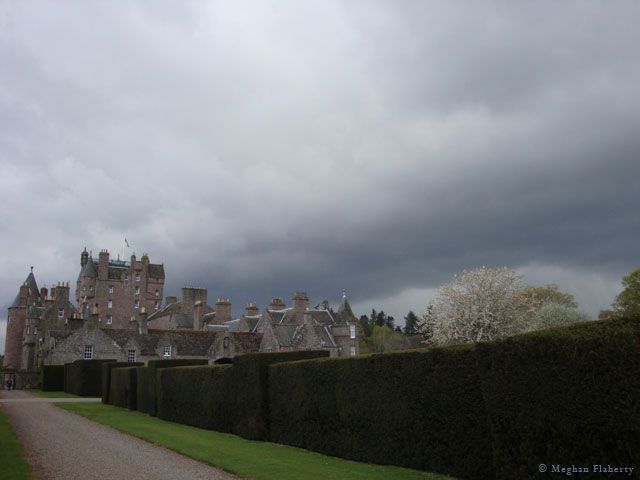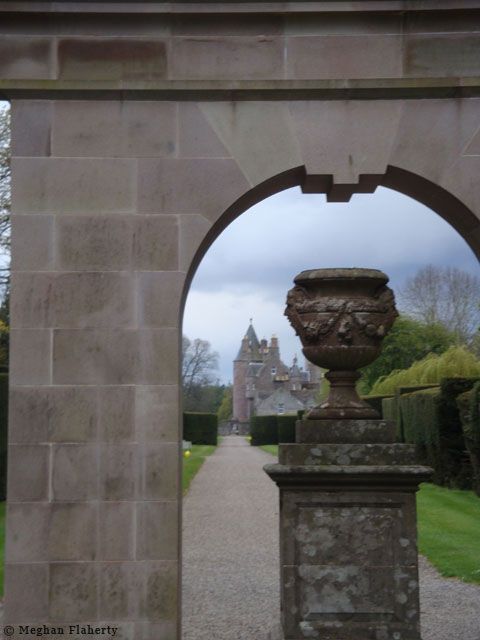Last Chance to Catch NYC's Holiday Notalgia Train
We met the voices of the NYC subway on our nostalgia ride this weekend!


 Glamis Castle and the Strathmore Estate on an afternoon in Spring (Angus, Scotland)
Glamis Castle and the Strathmore Estate on an afternoon in Spring (Angus, Scotland)
The Castle Glamis (pronounced “glamz” ) dominates the end of a long driveway, at the edge of a quaint town by the same name. There is a small shop and post office, with knit bears visible through the windows, and a warm pub that smells of butter-baking fish and roast potatoes, with deep red and wood-paneled walls, the Strathmore Arms.
Of literally hundreds in Scotland, Glamis Castle is perhaps the most grand. It is off the beaten path: two hours northeast of Glasgow by rented car, through Perth and Dundee. While most travelers look no further than Stirling or Edinburgh for their castle gawking-needs, the enterprising soul who makes the weekend trek will have the Vale of Strathmore almost to herself, sweeping views of rolling rapeseed-iridescent hills, hirsute Angus cows, and all the flowers of spring.
Glamis Castle is the childhood home of beloved Her Majesty Elizabeth the Queen Mother, who died in 2002 at 101 years of age. The entrance gates are a memorial to her, funded by public subscription and inaugurated by Prince Charles and Camilla in 2008. Just visible through the wrought iron and her Coat of Arms, are castle turrets and the fluttering Union Jack.
The castle and estates comprise the ancestral home of the Earls of Strathmore, since Sir John Lyon in 1372. The present structure is a prime example of Scottish castle architecture, under nearly constant renovation: Over the centuries, it has been a royal hunting lodge, a military garrison and a hospital in World War I. It was ransacked by King James the V-who had the 6th Lord Glamis’s widow, Lady Janet Douglas, burned at the stake in 1537-and is said to have been visited by such prestigious persons as Shakespeare, James “The Old Pretender,” Mary Queen of Scots, and Oliver Cromwell (who allegedly liberated all the silver and used the furniture for firewood). Decorative elements throughout commemorate the union of the Bowes and Lyon families with… bows and lions, elaborate color-coded crests depicting marriages, and the repeating theme of Scottish Thistle woven together with the Rose of England.
 View of Glamis Castle from the Italian Garden
View of Glamis Castle from the Italian Garden
Tours are just £9.75 ( £9 for seniors/students and £7.25 per child).
A well-educated docent in tartan skirt and uniform embroidered sweater takes you first through the Victorian Dining Room, installed in 1850 (which seats up to 36 for formal dinner and is available for private hire), then down to the medieval structure, the so-called Crypt, with walls three meters thick. The temperature drops by ten degrees. The ghost stories begin. This room would have been primarily for servants, dining and public business of the Earl, but it contains the celebrated “secret chamber”
-a walled up room which may or may not contain a family of clansmen who sought asylum and were murdered by starvation, or else an ancestor and company doomed to play cards with the Devil until Doomsday. Whatever’s in there-and there’s something in there-has not been seen for centuries; only a wall of stone is visible from the outside window. Up the spiral staircase, the vaulted guard room (remodeled in the 17th Century with stucco and Italian plasterwork) lets in some light before we move on to the private Chapel, and the second of many celebrated ghosts.
The Grey Lady, often seen praying on a little cane-backed corner chair is said to be the ghost of Janet Douglas, still sulking about her fiery fate.The Royal Apartments are next, and could not be more different: a suite of rooms arranged in 1923 for the Queen Mother-then the Lady Elizabeth Bowes Lyon-on her marriage into the English royal family in 1923. Our guide is quick with anecdotes about the many famous visitors and, yes, more ghosts. She even tells us how James “The Old Pretender” forgot his silver pocketwatch beneath his pillow when he imposed himself and 88 supporters on the castle’s hospitality (it was knicked by a servant girl, but never sold and is now safe in the Gallery downstairs).
The tour saves the best for last: the famous “Duncan Room,” where King Macbeth purportedly offed King Duncan in his eponymous tragic play. The murder, in fact, took place in Elgin, but Shakespeare’s choice to set his work in this stone room is understandable-it is claustrophobic and creepy, with one tiny, barred-over window that keeps an eye on visitors approaching up the drive. In Duncan’s room we also meet Fred the taxidermied bear, a former Lyon family pet brought in from Russia, who broke loose one day among the highland cattle and met his gory end. Our kindly docent pats him on the rump and thanks us for our attention.
As is typical of Scottish spring, we entered the castle on a sun-graced, albeit chilly, afternoon and exited to ambient grey and pouring rain, hoping no ghosts followed us out. For just under £10, plus the price of scones and tea, Glamis Castle offers an excellent afternoon adventure: a history lesson in Scottish-English intermarriage, a voyeuristic look into the life of the Queen Mother and ghost stories galore. The castle grounds are often opened for events: fireworks, festivals, outdoor stagings of Macbeth and, of course, haunted Halloweens.
Glamis Castle [Map]
Dundee Rd
Glamis, Forfar DD8 1RJ
United Kingdom
+44 (0) 1307 840393
Follow Untapped Cities on Twitter and Facebook! Get in touch with the author @msmeghanbean.
Subscribe to our newsletter